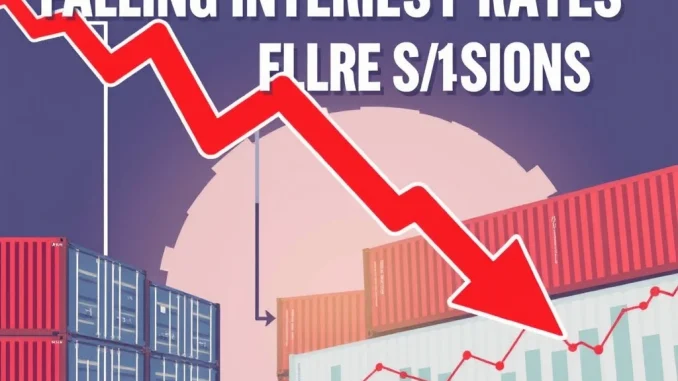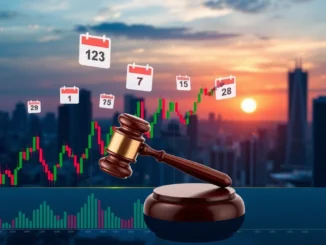
Are you ready for a potential shake-up in the financial world? The U.S. Commerce Secretary has just dropped a bombshell, predicting a significant interest rates drop in the near future! This news, coupled with a firm stance on tariffs, could trigger ripple effects across global markets, including the crypto space. Let’s dive into what this could mean for you and your investments.
Why Interest Rates Are Expected to Drop?
According to recent reports, U.S. Commerce Secretary Howard Lutnick has indicated that interest rates in the United States are poised for a substantial decrease. While the exact reasons weren’t explicitly detailed in the report, such statements from high-ranking officials often reflect underlying economic pressures or anticipated shifts in monetary policy.
Here’s what we can infer about potential factors driving this expected interest rates decrease:
- Economic Slowdown Signals: A potential drop in interest rates often signals concerns about economic growth. Central banks might lower rates to stimulate borrowing and spending if they foresee a slowdown.
- Inflation Concerns: While seemingly counterintuitive, if inflation is projected to fall, or if there are fears of deflation, central banks might reduce interest rates to encourage economic activity and prevent prices from falling too rapidly.
- Geopolitical Uncertainty: Global economic uncertainties, including trade tensions and geopolitical events, can prompt central banks to adopt a more accommodative monetary policy, which includes lowering interest rates.
- Market Stability: Lowering interest rates can be a tool to stabilize financial markets during times of volatility or stress, making borrowing cheaper and potentially boosting asset prices.
For cryptocurrency enthusiasts, lower interest rates can be a double-edged sword. On one hand, it can reduce the attractiveness of traditional fixed-income investments, potentially driving more capital towards riskier assets like cryptocurrencies. On the other hand, it reflects broader economic conditions that could also impact market sentiment.
Tariff Policy: No Exemptions and Ineffective Retaliation?
Adding another layer to this economic narrative, the Commerce Secretary also stated that there would be no exemptions from current tariff policies. Furthermore, he believes that retaliatory measures from other countries against these U.S. tariff policies would be ineffective. This firm stance suggests a continued commitment to the current trade strategy, despite international pushback and potential economic repercussions.
Let’s break down the implications of this unwavering tariff policy:
- Trade Tensions Persist: No exemptions mean that existing trade disputes and tensions are likely to continue. This can create uncertainty in global markets and impact supply chains.
- Cost Implications for Businesses: Tariffs increase the cost of imported goods. This can lead to higher prices for consumers and reduced profitability for businesses that rely on imported materials or sell goods in tariff-affected markets.
- Limited Retaliation Impact: The assertion that retaliatory measures are ineffective is a bold claim. It suggests the U.S. believes it can withstand economic pressure from other nations and that its market size and economic influence provide leverage.
- Potential for Trade Wars: If retaliatory tariffs are indeed deemed ineffective, it could embolden the U.S. to implement further tariffs, potentially escalating trade conflicts into full-blown trade wars.
For the crypto market, tariff policies can indirectly influence investment flows and market sentiment. Trade wars and economic uncertainty can sometimes drive investors towards alternative assets like Bitcoin as a hedge against traditional market volatility.
Impact on the US Economy: A Mixed Bag?
The combination of expected interest rates cuts and steadfast tariff policies paints a complex picture for the US economy. On one hand, lower interest rates could stimulate domestic investment and consumption. On the other hand, tariffs can increase costs for businesses and consumers, potentially offsetting the benefits of lower interest rates.
Here’s a potential outlook for the US economy:
| Positive Impacts (Interest Rate Cuts) | Negative Impacts (Tariff Policies) |
|---|---|
|
|
The net effect on the US economy will depend on the magnitude of the interest rate cuts, the duration and scope of tariff policies, and the global economic response to these measures.
Global Trade Dynamics: What to Expect?
The Commerce Secretary’s statements have significant implications for global trade. A U.S. lowering interest rates while maintaining tariffs can influence currency valuations, trade balances, and international investment flows. The dismissal of retaliatory tariff effectiveness further underscores a potentially confrontational approach to global trade relations.
Consider these potential shifts in global trade dynamics:
- Currency Fluctuations: Lower U.S. interest rates could potentially weaken the dollar relative to other currencies, making U.S. exports cheaper and imports more expensive (excluding tariff effects).
- Trade Balance Adjustments: Tariffs are intended to reduce trade deficits. However, their effectiveness is debated, and retaliatory tariffs can offset any potential gains.
- Supply Chain Reconfiguration: Prolonged trade tensions and tariffs might accelerate the trend of companies diversifying their supply chains away from heavily tariffed regions.
- Geopolitical Realignment: Trade policies are intertwined with geopolitics. Aggressive tariff policies can strain diplomatic relations and potentially lead to new trade alliances and blocs.
For the cryptocurrency market, global trade dynamics are relevant as they influence macroeconomic conditions and investor sentiment. Increased global economic uncertainty can sometimes be beneficial for decentralized, borderless assets like cryptocurrencies.
Market Impact and Crypto: Navigating the Uncertainty
The combined news of expected interest rates cuts and persistent tariffs will undoubtedly have a significant market impact. Traditional financial markets, as well as the cryptocurrency market, will likely react to these developments.
Here’s how these factors might influence the market impact, particularly on crypto:
- Equity and Bond Markets: Lower interest rates are generally positive for equity markets (making stocks more attractive) and bond markets (increasing bond values). However, tariff uncertainties can create volatility and dampen investor enthusiasm.
- Currency Markets: As mentioned, interest rate differentials and trade policies can lead to currency fluctuations, impacting forex markets and potentially influencing the value of stablecoins pegged to fiat currencies.
- Commodity Markets: Tariffs directly impact commodity prices, especially those subject to import duties. Lower interest rates can also influence commodity demand.
- Cryptocurrency Markets: In times of economic uncertainty and low interest rates, cryptocurrencies can be seen as alternative investments. Furthermore, any weakening of the US dollar could make Bitcoin and other cryptocurrencies relatively more attractive as stores of value.
For crypto investors, staying informed and understanding these macroeconomic trends is crucial. While the crypto market has its own dynamics, it’s not immune to broader economic forces.
Conclusion: Prepare for Potential Market Shifts
The U.S. Commerce Secretary’s pronouncements on impending interest rates cuts and unwavering tariff policies signal a potentially significant shift in the economic landscape. For cryptocurrency holders and traders, these developments warrant close attention. While lower interest rates could create a more favorable environment for risk assets like crypto, the ongoing trade tensions and their broader market impact introduce considerable uncertainty.
Navigating these waters will require vigilance, a keen understanding of macroeconomic trends, and a balanced investment strategy. Stay informed, stay agile, and be prepared for potential market volatility as these policies unfold.



